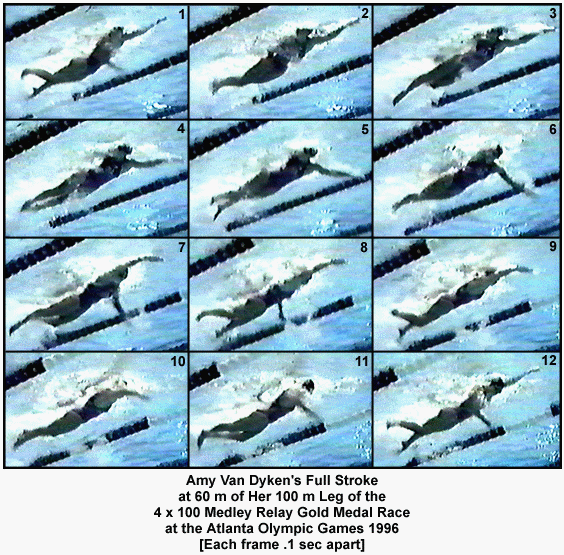HOW CHAMPIONS DO IT
Researched, produced, and prepared by Brent S. Rushall,
Ph.D., R.Psy.

AMY VAN DYKEN'S FULL STROKE AT 60 m OF HER 100 m LEG OF THE 4 x 100 MEDLEY RELAY GOLD MEDAL RACE AT THE ATLANTA OLYMPIC GAMES 1996
Each frame is .1 second apart. Amy Van Dyken's split for this leg of the relay was 54.17 seconds.
Notable Features
- Frame #1: The left arm has entered the water at full stretch. The right arm is in the middle of its effective propulsion phase. The right leg has commenced kicking to balance the vertical force component of the left arm entry. The head is starting to turn to the right in the breathing action.
- Frame #2: The left arm remains extended forward as the right arm extends backward to continue propulsion. The head has turned further and the right leg continues to kick.
- Frame #3: The right hand has just exited. The head has almost completed its turn prior to inhalation. The right leg has completed its kick as the left hand/arm accelerates down and still well forward. Some of the downward force (a positive vertical force) created by the left hand/arm is counter-balanced by the recovering right arm (which also creates a negative vertical force). The left leg prepares to kick. The hips are not rotated to the same degree as the shoulders.
- Frame #4: The left arm/hand continues to press down while holding an extended position forward. The wrist has started to flex as the first preparatory movement to change the pulling direction to backward. The left leg kicks to balance the vertical forces created by the recovering right arm. This kick also causes the hips to remain relatively stable. Inhalation occurs.
- Frame #5: The left arm starts to press backward and downward, caused mainly by adduction of the upper arm. Inhalation is completed and the head return is initiated. The left leg kick is completed as the recovery of the right arm reaches its highest point. The right leg prepares for a modified kick.
- Frame #6: The left arm pull changes by bending at the elbow, and results in more direct propulsion being developed backward. Adduction of the upper left arm continues. The right leg kicks to counter-balance forces created by both arms (one in propulsion, the other in a late stage of recovery). The head is well into the return stage.
- Frame #7: Left arm propulsion continues with the hand/forearm surface being used to push mostly backward. The upper left arm is at its limit of adduction and will support elbow extension. The head has returned but its profile is slightly forward. The shoulders are flat. The right arm enters fully stretched but flexed at the wrist. As with most top crawl stroke swimmers, this is the phase of the stroke when maximum "length" is attained (the arm is stretched, the body is flat, a leg is extended, and the foot plantar flexed).
- Frame #8: Left arm propulsion continues with extension at the elbow. The upper arm has risen to facilitate rounding out. The left leg has kicked to counter-balance the right arm entry and continued shoulder rotation to the right. The right leg is raised preparatory to kicking. The profile of the face has been oriented more to the pool bottom.
- Frame #9: The left arm has exited and the right leg kicks to counter-balance its vertical force component. The right arm flexes at the elbow and wrist. The head, torso, hips, and thighs are streamlined. The shoulders are completing their rotation to the right.
- Frame #10: The right arm pull increases in effectiveness as adduction of the upper arm, some medial rotation of the upper arm, and more flexion at the elbow occurs. The shoulders have stopped rotating. The right leg kicks to balance forces created by the recovering left arm and the left leg prepares to kick.
- Frame #11: Very rapid adduction of the upper right arm creates a very powerful "pull" (although in actuality the body is moving past the arm much faster than the arm is pulling "through" the water). The right leg rises to kick and the left leg kicks to balance vertical forces created by the pull and recovery.
- Frame #12: The left arm enters as the left leg kick is completed. The right leg is raised preparatory to kicking to counter-balance the left arm entry. The head is well down and in streamline with the torso and thighs. The right arm continues to propel mainly in a backward and horizontal direction.

Return to Table of Contents for this section.




